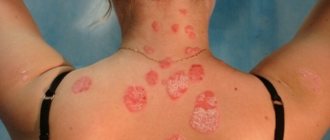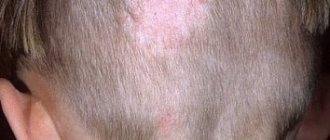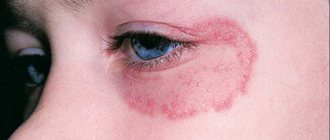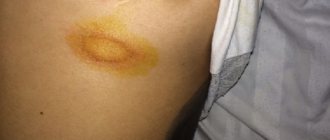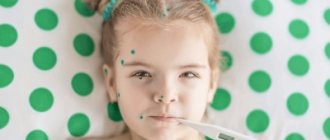An infectious disease such as ringworm is caused by various types of fungi, most often of the Microsporum or Trichophyton genus.
Cost of services in our clinic
| Appointment with a dermatologist, candidate of medical sciences | 1500 rub. |
| Consultation with a dermatologist (KMS) when removing 2 tumors | 0 rub. |
| Removal of a neoplasm (wart, mole) using the radio wave method | 500 rub. |
| Make an appointment by phone: 8-800-707-15-60 (toll-free) |
| *The clinic is licensed to remove tumors |
The disease manifests itself in the form of pinkish, scaly, rounded spots on the skin. The incubation period is one to two weeks from the moment of infection.
Causes and types of disease
Ringworm, microsporia, trichophytosis is a disease transmitted to humans from animals. Very often children who play with stray cats and dogs become infected. The disease can also be caught from a sick person through hygiene items, personal belongings and through direct contact.
Factors that provoke the appearance of ringworm in a person include:
- Contact with a sick animal, often a cat or dog. Infection is possible, including through lost fur. In this case, the disease is designated by the term microsporia, as it is caused by a fungus of the genus Microsporum, and is characterized by a more severe course.
- Ringworm is contracted through direct interaction with a sick person, for example, through handshakes and hugs. A fungus of the genus Trichophyton can parasitize humans. In this case, the term trichophytosis is used to refer to the disease.
- Infection through household and hygiene items: shared towels, soap, washcloth, comb, as well as dishes, shoes or clothing used by a sick person. Transmission of the fungus can occur by touching a surface that has been touched by someone infected with ringworm.
Treatment of deprivation
Today, the question of how best to treat lichen on the hands is considered quite relevant. Since there are quite a lot of varieties of lichen and they all differ in nature, that’s why they are treated differently.
There are two methods of treating the disease:
- medicinal;
- folk
Symptoms and complications
This lichen is called ringworm because when it is infected, the hair on the head breaks off at a distance of about half a centimeter from the skin and appears as if it has been cut off. As a result, bald spots are formed and increase in size. Reddish spots with a bright ridge around the circumference form on the body, vellus hair breaks off at the site of the lesion, turning into nodules. It creates the feeling of a seal placed on the skin.
In people with weakened immunity and severe concomitant diseases, severe forms of trichophytosis occur:
- Infiltrative
, in which gray swollen spots appear on the skin, quickly increasing in size. The patient's temperature rises and the lymph nodes in the affected area become enlarged. - Purulent
, characterized by deep skin lesions with the release of pus and the appearance of ulcers on the surface of the lichen. Sometimes purulent contents appear in the form of yellow cloudy drops. Patients' general condition worsens, their temperature rises, and their lymph nodes become enlarged. Without treatment, blood poisoning may occur.
The fungus can affect various parts of the body, including the arms, legs, and face. Foci of the disease also form on the scalp, and in men - in the area of the mustache and beard. The disease often affects the nails, and the hands and feet may also be affected. Particularly unpleasant sensations are caused by the formation of plaques in the armpits or in the groin folds.
Ringworm is characterized by symptoms such as:
- burning and itching in the affected area;
- swelling, pain, purulent discharge that occurs in advanced cases;
- dandruff and focal baldness when spots are localized in the hairline area;
- general weakness and malaise.
In children, during exacerbation of the disease, episodes of fever, enlarged lymph nodes, and disturbances in the functioning of the digestive system are common. If the treatment is not started in a timely manner or is chosen incorrectly, the disease can become chronic.
Lichen. Types, symptoms, treatment
Since the 18th century, the term “lichen” (“lichen”, “infection” in Greek) has been used to describe most skin diseases, which at certain stages of their development were accompanied by itchy small nodules.
Currently, the lichen group includes 3 diseases:
- lichen planus;
- ringworm;
- lichen linear.
The term “lichen” is so rooted in the dermatological classification that it has become integral in the definition of such completely different dermatoses as lichen rosea of Zhibera, pityriasis versicolor, lichen simplex vesicularis, lichen herpes, lichen white atrophic Tsumbusha, lichen planus or psoriasis, ringworm or microsporia and others. Thus, the causes of the development of “lichen” can be either viral or fungal agents, or genetic factors, endocrine or neurological disorders. And many fairly well-known and common diseases, such as psoriasis and lichen planus, are currently not fully understood.
Let's look at typical representatives of the lichen group:
Lichen red flat is a common skin disease that affects the skin and mucous membranes, and less often the nails. The most common theories are the infectious and neurogenic origin of the disease. It occurs in adults, more often in women aged 30-60 years. The rashes are located mainly on the flexor surfaces of the forearms, abdomen, and lower back. The rash is characteristic in the form of small 1-3mm polygonal reddish-violet nodules with a flat shiny surface and an umbilical depression in the center. On the surface of larger elements, a whitish mesh pattern is revealed - Wickham's mesh, which is very typical for this disease. Papules can merge into small plaques or form linear or ring-shaped figures, fresh rashes appear at the site of injury (Koebner phenomenon). Severe itching is characteristic. The duration of the disease ranges from several months to several years. Damage to the mucous membranes of the oral cavity or genital organs can be either isolated or combined with the skin. On the inner surface of the cheeks, the red border of the lips, the lateral surfaces of the tongue, on the vulva or head of the penis, there are small whitish shiny papules that form a “fern” or “mesh” pattern.
There are several clinical forms of lichen planus:
- hypertrophic form (in the form of dense warty plaques of a stagnant red or bluish tint);
- atrophic form (rash in the form of spots with a characteristic purple color);
- cystic form (vesicles or blisters with serous contents appear on the surface of the nodules, and erosive and ulcerative defects appear in places of friction);
The erosive-ulcerative form often develops in patients with diabetes mellitus and hypertension (erosions and small ulcers are surrounded by typical papules). Follicular form (small nodules at the mouths of hair follicles). Pigmented form (pigmentation precedes the formation of papules, limited lesions in the abdomen, buttocks, lower extremities).
Lichen (lichen) shiny is a dermatosis characterized by the presence of small papules, reminiscent of papules in lichen planus, the development of which is based on a granulomatous reaction. It is generally accepted that lichen planus is a kind of lichenoid reaction to parasitosis, chronic diseases of the ENT organs and gastrointestinal tract. The disease occurs mainly in children, more often in boys.
Papules are located on the skin of the penis, in the area of the knee and elbow joints, and the rash may spread. Lichen brilliant papules are small 1-2 mm, flat, with a smooth surface, round or polygonal, flesh-colored or pale pink with a pearlescent tint. The rashes are multiple, but never merge and may be at the site of injury. Itching doesn't bother me. The course of the disease is long, sometimes reaching 15-20 years, and can resolve spontaneously.
Lichen (lichen) linear - dermatosis,
characterized by the presence of papular rashes that have a linear arrangement.
Since the rashes are located linearly, usually along the extremities, the background for the development of dermatosis can be damage to the peripheral nerves. The disease occurs in all age groups, more often in women. The upper and lower extremities are affected, rashes in the form of small papules up to 2 mm in color, pale pink or reddish-brown, slightly rising above the surface of healthy skin, closely adjacent to each other and form linear lesions up to 2 cm wide and up to several tens of centimeters long. On the surface of the plaques, peeling from minor to severe psoriasiform itching is possible. The duration of the disease usually does not exceed several months, although sometimes it can last for several years. The diagnosis of lichen is made clinically and can be confirmed by histological examination of the skin. Treatment of “lichen” is predominantly outpatient, taking into account the provoking and concomitant pathologies in a particular patient. Since the course of the disease is often long-term, the patient is recommended to undergo clinical observation by a dermatologist, examination, treatment, including pure sanatorium-resort rehabilitation. The sooner the correct diagnosis is made to the patient, the more effective the treatment methods used will be and the desired result will be achieved!
Diagnosis and treatment of ringworm
Before starting treatment, you need to make a correct diagnosis. Differential diagnosis is carried out by a dermatologist based on the patient’s complaints and existing symptoms.
In ringworm, the plaques are round, edged with vesicles or scales, and have a reddish spot in the center. To distinguish trichophytosis from other skin diseases, the spots are irradiated with a Wood's lamp. The illuminated lichen lesion has a bluish-green color. When skin particles are inoculated in the laboratory, “fluffy” colonies of the fungus grow.
Additionally, a special analysis is taken using the scraping method to determine the type of fungus.
Symptoms
The first symptoms of lichen on the hands are the following:
- itching, discomfort and burning in areas of future lesions;
- the appearance of weeping watery blisters of various shapes;
- peeling of the skin;
- changes in the structure of the skin due to the appearance of plaques on it.
Folk
Having dealt with drug treatment, it’s worth talking about “grandmother’s methods.” Sometimes their advice for quickly treating lichen on the hands can come in handy.
There are such popular recipes for the treatment of lichen in folk conditions:
Onion juice. Rub intensively into the source of infection 2 times a day. The rim is rubbed especially carefully. The procedure continues until the symptoms of the disease disappear completely.
If lichen has affected the palms, then burdock oil is rubbed into them until completely absorbed. It is not recommended to wash your hands after the procedure for about 30 minutes.
You need to burn the newspaper, make a liquid from the ashes, add a little water and rub it on the affected areas.
All these simple procedures answer the question of how to easily cure lichen at home.
Medication
Drug treatment involves visiting a dermatologist, followed by a series of tests and prescription of medications.
The following groups of drugs are widely used:
- antibiotics;
- hormonal ointments;
- antihistamines;
- vitamins.
Prevention
There are a number of measures that will help avoid the disease:
- avoiding contact with infected people and animals;
- observe the rules of personal hygiene;
- use only your personal items;
- do not overcool and try to avoid stress;
- strengthen your immune system.
By following all these rules, you can avoid the formation of lichen on your hands.


